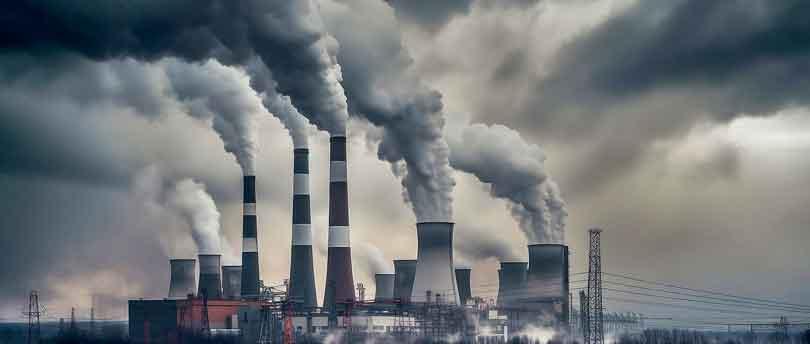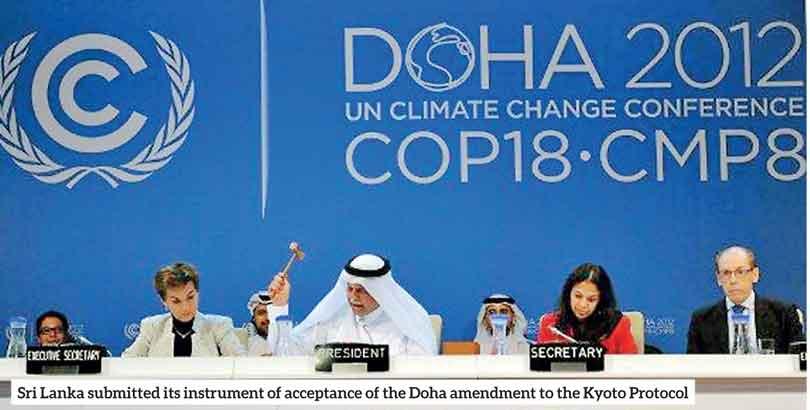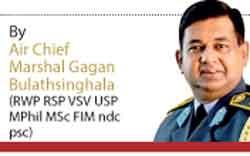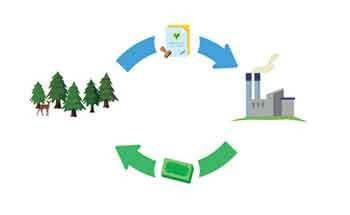Reply To:
Name - Reply Comment
Last Updated : 2024-05-14 20:28:00


 In Sri Lanka, the Carbon Crediting Scheme (SLCCS) is a national offset scheme established to support local clean projects to benefit from climate finance for Greenhouse Gas emission (GHG) reduction.
In Sri Lanka, the Carbon Crediting Scheme (SLCCS) is a national offset scheme established to support local clean projects to benefit from climate finance for Greenhouse Gas emission (GHG) reduction.
This scheme is developed with well-defined provisions to enhance credibility, transparency and quality of emission reduction in Sri Lanka. In an era, where vast opportunities are growing for low-cost GHG reduction projects, SLCCS enables it to bring multiple benefits to the environment, society and economy.
Definition
 A carbon offset is a way of compensating for emissions of carbon dioxide or other greenhouse gases. It is a reduction or removal of emissions to compensate for other emissions elsewhere. A carbon credit or offset credit is a transferrable instrument that governments or independent certification bodies have certified. It represents an emission reduction of one metric ton of carbon dioxide or CO2. It can also represent an equivalent amount of other Green House Gases (GHGs). Carbon offsets and credits are a form of carbon pricing, along with carbon taxes and subsidies. The concepts of offsets and credits are linked.
A carbon offset is a way of compensating for emissions of carbon dioxide or other greenhouse gases. It is a reduction or removal of emissions to compensate for other emissions elsewhere. A carbon credit or offset credit is a transferrable instrument that governments or independent certification bodies have certified. It represents an emission reduction of one metric ton of carbon dioxide or CO2. It can also represent an equivalent amount of other Green House Gases (GHGs). Carbon offsets and credits are a form of carbon pricing, along with carbon taxes and subsidies. The concepts of offsets and credits are linked.
Both offsets and credits can move among the various markets they are traded. https://carbonpricingdashboard.worldbank.org/what-carbonpricing#:~:text=Carbon%20pricing%20is%20an%20instrument,to%20their%20 sources%20through%20a
Carbon markets
Carbon markets are the trading systems in which carbon credits are sold and bought. Companies or individuals can use carbon markets to compensate for their greenhouse gas (GHG) emissions by purchasing carbon credits from entities that remove or reduce greenhouse gas emissions. One tradable carbon credit equals one ton of carbon dioxide or the equivalent amount of a different greenhouse gas reduced, sequestered or avoided. When a credit is used to reduce, sequester, or avoid emissions, it becomes an offset and is no longer 2 tradable. A  carbon credit is the representation of a ton of carbon that is no longer emitted into the atmosphere, contributing to the reduction of the greenhouse effect.
carbon credit is the representation of a ton of carbon that is no longer emitted into the atmosphere, contributing to the reduction of the greenhouse effect.
There are several ways to generate carbon credits, including the substitution of fuels in factories, where they stop using non-renewable biomass, such as firewood from deforestation, and start using renewable biomass, which in addition to emitting less greenhouse gases, contribute to the reduction of deforestation.
Carbon credit is the currency used in the carbon market. In this market, companies that have a very high level of emissions and few options for reduction can buy carbon credits to offset their emissions.
Thus, it indirectly helps to maintain the reduction project and, in addition to balancing the level of the emissions into the atmosphere, contribute to the sustainable development of poor communities. https://www.sustainablecarbon.com/en/como-sao-gerados
Kyoto Protocol and Paris Agreement
On December 11, 1997, the United Nations Framework Convention on Climate Change (UNFCCC) was linked to what is known as the Kyoto Protocol in Kyoto, Japan. It is an international agreement that sets specific targets for 37 industrialized countries and the European community for reducing Green House Gas emissions, approximately by about 5 percent.
Owing to a complex ratification process, it entered into force on 16 February 2005. Currently, there are 192 parties to the Kyoto Protocol (191 States and 1 regional economic integration organization) the European Union, Cook Islands, Niue, and all UN member states except Andorra, Canada, South Sudan, and the United States as of 2022.
Surprisingly, this excludes the United States, the most noted polluter in the modern world. 3 Percentages in this depiction may not add up to 100% due to independent rounding and the way the inventory quantifies the U.S. as a separate sector. Further, it’s based on gross total emissions excluding emissions and removals from the land use, land use change and forestry sector.
U.S. Environmental Protection Agency. https://cfpub.epa.gov/ghgdata/inventoryexplorer/ The Kyoto Protocol treaty has established three mechanisms that enable countries or operators in developed countries to acquire offset credits. The economics behind these programs were that the marginal cost of reducing emissions would differ among countries.
Research suggests that the flexibility mechanisms could reduce the overall cost of meeting the targets. As discussed, the Kyoto Protocol is based on the principles and provisions of the Convention and follows its annex-based structure.
It only binds developed countries and places a heavier burden on them under the principle of “common but differentiated responsibility and respective capabilities”, because it recognizes that they are largely responsible for the current high levels of GHG emissions in the atmosphere.
Sri Lanka submitted its instrument of acceptance of the Doha amendment to the Kyoto Protocol to the United Nations Framework Convention on Climate Change on 2 December 2015.
Sri Lanka Accepts KP Amendment 4 December 2015 https://unfccc.int/news/sri-lanka-accepts-kp-amendment https://unfccc.int/kyoto_protocol 4.
A variety of greenhouse gas reduction projects could be used to create offsets and credits. Forestry projects are the fastest-growing category. Renewable energy is another common type and includes wind farms, biomass energy, biogas digesters, or hydroelectric dams. Other types include energy efficiency projects, such as efficient cookstoves, and the destruction of landfill methane. Further include methods that use negative emission technologies, such as biochar, carbonated building elements, and geologically stored carbon. The primary ingredient for making biochar is a copious quantity of agricultural waste. Covered with tea, rubber and cinnamon plantations, Sri Lanka has no shortage of residual biomass.
Traditionally, these vegetative remnants and offcuts would be sold for firewood or simply thrown into a heap and burned. https://en.wikipedia.org/wiki/Carbon_offsets_and_credits#:~:text=A%20variet y%20of%20projects%20have,and%20carbon%2Dnegative%20fuels).
Other International Programs
Protecting the forests is crucial for the climate. Forests absorb vast amounts of carbon dioxide and can be a source of greenhouse gas emissions when destroyed or damaged. Countries established the ‘REDD+’ framework to protect forests as part of the Paris Agreement. ‘REDD’ stands for ‘Reducing Emissions from Deforestation and Forest Degradation in developing countries.
The ‘+’ stands for additional forest-related activities that protect the climate, namely sustainable management of forests and the conservation and enhancement of forest carbon stocks. Under the framework of these REDD+ activities, developing countries can receive results-based payments for emission reductions when they reduce deforestation. This serves as a major incentive for their efforts. Carbon Credits and Sri Lanka Carbon credits could help Sri Lanka in several ways by providing economic and environmental benefits.
Some of the potential ways in which carbon credits can be beneficial to Sri Lanka are; Mitigation of Climate Change: Sri Lanka can participate in carbon credit programs to reduce its greenhouse gas emissions.
This could involve implementing projects that promote renewable energy, energy efficiency, afforestation, and sustainable agricultural practices. By earning carbon credits through these initiatives, Sri Lanka can contribute to global efforts to mitigate climate change. Revenue Generation: Carbon credits can be bought and sold on international markets. By earning carbon credits through sustainable projects, Sri Lanka can sell these credits to countries or companies that exceed their emission targets. This creates a new revenue stream for the country, which can be reinvested in further sustainable development projects.
Renewable Energy Projects:
We can develop and invest in renewable energy projects such as wind, solar, hydropower or a hybrid solution that could have a 5 combination of all of them.
These projects can generate carbon credits by displacing the need for fossil fuel-based energy sources.
Additionally, they contribute to the country’s energy security and reduce dependence on imported fuels. Rural Development: Carbon credit projects often involve activities in rural areas, such as reforestation and sustainable agriculture. These projects can lead to employment creation and improved livelihoods for local communities on agroforestry projects that impound carbon and can provide additional income for the farmers. International Collaboration: Participation in carbon credit programs fosters international collaboration and partnerships.
Sri Lanka could work with other countries, non-governmental organizations, and private entities to implement and finance projects that reduce emissions and enhance sustainability. Environmental Conservation: Carbon credit projects often involve initiatives that contribute to environmental conservation, such as protecting biodiversity and preserving natural habitats.
These activities can have a positive effect on the country’s ecosystems and biodiversity. Compliance with International Agreements: Sri Lanka’s involvement in carbon credit programs can help the country meet its commitments under international agreements such as the Paris Agreement, by actively participating in global efforts to address climate change. In addition, Sri Lanka can enhance its reputation and relationships on the international stage.
Climate Fund
The Sri Lanka Climate Fund is a government-owned company established under the Companies Act No.7 of 2007 of Sri Lanka. This fund’s effort is to build a new low-carbon business economy and low-carbon life patterns.
While optimizing carbon emission performance in existing facilities, the company is looking to explore the potential for new effective low-carbon solutions through innovative strategies and collaboration with local and International markets.
Further, it’s essential to take cognizance that the success of carbon credit initiatives depends on effective project implementation, monitoring, and verification. Additionally, the regulatory framework and market conditions for carbon credits can influence their overall impact. Importantly a national instrument and collaboration between all stakeholders would pave the way for the successful implementation of the initiatives. https://www.climatefund.lk/slcf_index Inference “The small island countries…are on the frontline of being swallowed into an abyss, created initially by human activity and increasingly by inaction. Our vulnerabilities as states on the frontline are profound,” Hubert Minnis, Prime Minister of the Bahamas.
World leaders spoke bluntly about the climate crisis, echoing an emotional displeasure during the UN’s Climate Action Summit on Sept. 2023. 6 Climate change scares our survival in many ways as it has physical and psychological effects. Sri Lanka has an inordinate need for change.
It needs to adopt practices that will not only ensure reductions in GHG emission levels but, more importantly, adapt measures to ensure a safe future. It can be easily assimilated that climate change is directly affecting Sri Lanka, whereby we need to look specifically at the impact on Sri Lanka’s environment, agriculture, tourism, health, and society at large. We being a developing nation need to increase domestic and foreign investments to further our infrastructure and industry to join the rapidly developing nations.
Climate change can hinder this process dramatically if efforts are not taken to reduce and arrest the present-day trends.
Leading stakeholders in this issue the United States, European Union, and China, along with most other developed nations need to consider the negative impact of their industries and curb these industries in a way which will reduce the bearing on climate change. It is the developing nations like us that will suffer first and most.
We seem to be playing its role well in terms of environmental indicators but, it still has a long way ahead. The policies and measures that governments and other international organizations are implementing to help reduce the negative impacts of climate change are commendable.
Sri Lanka’s Climate Fund and the Carbon Crediting Scheme (SLCCS) are two very respectable national initiatives. It is of the view that both these initiatives need an aggressive awareness campaign amongst the public at large. These instruments need a further intensive and proactive approach to capture the target audience. It is the view that Sri Lanka should accelerate measures to adapt to climate change before it is too late. Even though Sri Lanka has a relatively minor role in mitigating this global threat, Sri Lanka and the whole world will nevertheless have to face this challenge as one. https://www.american.edu/cas/economics/ejournal/upload/baba_accessible.
The writer is formerly Commander Sri Lanka Air Force and Ambassador to Afghanistan President of the Association of Retired Flag Rank Officers.
Ranil Thursday, 07 December 2023 06:21 AM
Carbon trading is a total scam. There is no way to lock up fossil carbon 200 million years old in a tree that only lives for 200 years. Please stop attempting to bamboozle us with bad science.

Add comment
Comments will be edited (grammar, spelling and slang) and authorized at the discretion of Daily Mirror online. The website also has the right not to publish selected comments.
Reply To:
Name - Reply Comment
US authorities are currently reviewing the manifest of every cargo aboard MV
On March 26, a couple arriving from Thailand was arrested with 88 live animal
According to villagers from Naula-Moragolla out of 105 families 80 can afford
Is the situation in Sri Lanka so grim that locals harbour hope that they coul